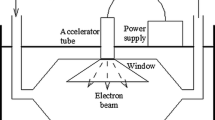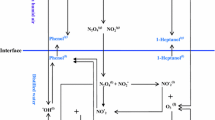Abstract
In this study, benzene was selected as an indicator of VOCs, and a modeling procedure was carried out on benzene removal (outflow concentration of benzene, C/inflow concentration of benzene, C0), in DC and AC non-thermal plasma systems. Different diameters (18, 23, and 36 mm) of wire-tube plasma reactors were prepared, and models were raised based on the results of experiments with influencing factors of the used voltage, gap size inside the reactor, current density, and specific energy. The results showed correlation between the factors and benzene removal in both DC and AC discharge non-thermal plasma. The applied voltage as an electrical factor had negative correlation with C/C0, and the correlation was stronger than for gap size which was positively correlated with C/C0. Current density and specific energy were affected by the voltage and gap size of the reactor; the lowest C/C0 values were obtained in the highest values of specific energy and current density. Regarding the raised models, multi-factor exponential model was the most reliable one with the results.



Similar content being viewed by others
References
Assadi, A. A., Bouzaza, A., Merabet, S., & Wolbert, D. (2014). Modeling and simulation of VOCs removal by nonthermal plasma discharge with photocatalysis in a continuous reactor: synergetic effect and mass transfer. Chemical Engineering Journal, 258, 119–127.
Boyle, W., & Kisliuk, P. (1955). Departure from Paschen's law of breakdown in gases. Physical Review, 97(2), 255.
Cal, M. P., & Schluep, M. (2001). Destruction of benzene with non-thermal plasma in dielectric barrier discharge reactors. Environmental Progress, 20(3), 151–156. https://doi.org/10.1002/ep.670200310.
Chang, J.-S. (2003). Next generation integrated electrostatic gas cleaning systems. Journal of Electrostatics, 57(3–4), 273–291. https://doi.org/10.1016/S0304-3886(02)00167-5.
Fazlzadeh Davil, M., Naddafi, K., Rostami, R., Zarei, A., & Feizizadeh, M. (2013). A mathematical model for predicting 24-h variations of BTEX concentrations in ambient air of Tehran. International Journal of Environmental Health Engineering, 2(1), 4.
Fridman, A., & Kennedy, L. A. (2004). Plasma physics and engineering. CRC press.
Hazrati, S., Rostami, R., Fazlzadeh, M., & Pourfarzi, F. (2015). Benzene, toluene, ethylbenzene and xylene concentrations in atmospheric ambient air of gasoline and CNG refueling stations. Air Quality, Atmosphere & Health, 1–7, doi:https://doi.org/10.1007/s11869-015-0349-0.
Hyun-Ha, K., Atsushi, O., & Shigeru, F. (2005). Atmospheric plasma-driven catalysis for the low temperature decomposition of dilute aromatic compounds. Journal of Physics D: Applied Physics, 38(8), 1292.
Karatum, O., & Deshusses, M. A. (2016). A comparative study of dilute VOCs treatment in a non-thermal plasma reactor. Chemical Engineering Journal, 294, 308–315. https://doi.org/10.1016/j.cej.2016.03.002.
Kim, Y. M., Harrad, S., & Harrison, R. M. (2001). Concentrations and sources of VOCs in urban domestic and public microenvironments. Environmental Science & Technology, 35(6), 997–1004.
Li, D., Yakushiji, D., Kanazawa, S., Ohkubo, T., & Nomoto, Y. (2002). Decomposition of toluene by streamer corona discharge with catalyst. Journal of Electrostatics, 55(3), 311–319.
Mok, Y. S., Lee, H. W., Hyun, Y. J., Ham, S. W., & Nam, I.-S. (2001). Determination of decomposition rate constants of volatile organic compounds and nitric oxide in a pulsed corona discharge reactor. Korean Journal of Chemical Engineering, 18(5), 711–718. https://doi.org/10.1007/bf02706391.
NIOSH (2003). NIOSH manual of analytical methods (NMAM), fourth edition. Hydrocarbons, Aromatic (Vol. 1501). 1600 Clifton Rd. Atlanta, GA 30329-4027, USA: Centers for Disease Control and Prevention.
Oda, T. (2003). Non-thermal plasma processing for environmental protection: Decomposition of dilute VOCs in air. Journal of Electrostatics, 57(3), 293–311.
Parker, K. R. (2012). Applied electrostatic precipitation. Springer Science & Business Media.
Qin, C., Dang, X., Huang, J., Teng, J., & Huang, X. (2016). Plasma-catalytic oxidation of adsorbed toluene on Ag–Mn/γ-Al2O3: comparison of gas flow-through and gas circulation treatment. Chemical Engineering Journal, 299, 85–92. https://doi.org/10.1016/j.cej.2016.04.093.
Rostami, R., & Jafari, A. J. (2014). Application of an adsorptive-thermocatalytic process for BTX removal from polluted air flow. Journal of Environmental Health Science and Engineering, 12(1), 89.
Rostami, R., Moussavi, G., Jonidi Jafari, A., & Darbari, S. (2017). Decomposition of benzene using wire-tube AC/DC discharge reactors. Journal of Electrostatics, 87, 158–166.
Wang, W., Fan, X., Zhu, T., Wang, H., Ye, D., & Hong, X. (2016). Removal of gas phase dimethylamine and N,N-dimethylformamide using non-thermal plasma. Chemical Engineering Journal, 299, 184–191. https://doi.org/10.1016/j.cej.2016.04.045.
Xu, N., Fu, W., He, C., Cao, L., Liu, X., Zhao, J., et al. (2014). Benzene removal using non-thermal plasma with CuO/AC catalyst: reaction condition optimization and decomposition mechanism. Plasma Chemistry and Plasma Processing, 34(6), 1387–1402.
Yamamoto, T. (1997). VOC decomposition by nonthermal plasma processing—A new approach. Journal of Electrostatics, 42(1), 227–238.
Zhu, L., & Wang, J. (2003). Sources and patterns of polycyclic aromatic hydrocarbons pollution in kitchen air, China. Chemosphere, 50(5), 611–618. https://doi.org/10.1016/S0045-6535(02)00668-9.
Acknowledgments
This work is carried out under the funding of Tarbiat Modares University. The authors express their gratitude to supporting the research.
Author information
Authors and Affiliations
Corresponding author
Additional information
Publisher’s note
Springer Nature remains neutral with regard to jurisdictional claims in published maps and institutional affiliations.
Rights and permissions
About this article
Cite this article
Rostami, R., Moussavi, G., Jafari, A.J. et al. A modeling concept on removal of VOCs in wire-tube non-thermal plasma, considering electrical and structural factors. Environ Monit Assess 192, 280 (2020). https://doi.org/10.1007/s10661-020-8241-2
Received:
Accepted:
Published:
DOI: https://doi.org/10.1007/s10661-020-8241-2




